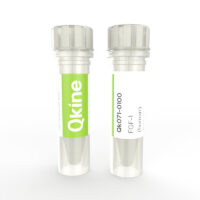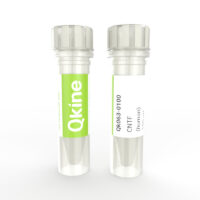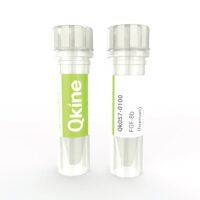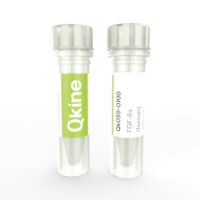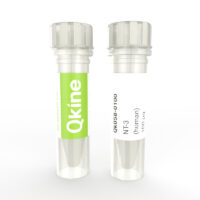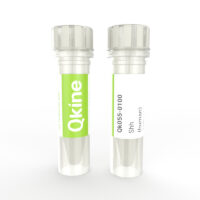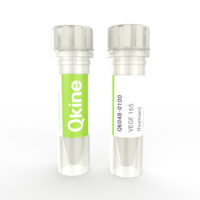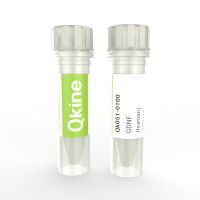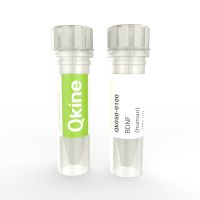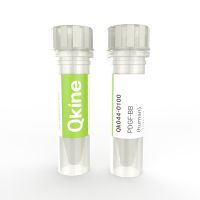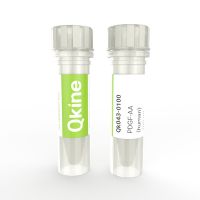- Fibroblast Growth Factor 1 (FGF-1) regulates the proliferation, migration, and differentiation of mesenchymal cells, with roles in embryonic development, tissue regeneration, and wound healing. FGF-1 also has neurotrophic and lipid metabolism functions and can promote hematopoietic stem cell differentiation. It is implicated in tumor growth and migration.In vitro, FGF-1 can stimulate growth and differentiation of endothelial and epithelial cells and the development of organoids. FGF-1 can also be used for the maintenance of oligodendrocytes and astroglia as well as bone marrow-derived mesenchymal and hematopoietic stem cells.Human FGF-1 has a molecular weight of 15.9 kDa. This protein is carrier-free and tag-free to ensure its purity with exceptional lot-to-lot consistency. Qk071 is suitable for the culture of reproducible mesenchymal, endothelial, haematopoietic, glial, and other relevant cells.
- Ciliary Neurotrophic Factor (CNTF) is a member of the IL-6 family of cytokines. CNTF plays a crucial role in developing and maintaining the nervous system, in particular the optic nervous system. It promotes the maintenance, differentiation, and survival of various neurons, glial cells, and retinal cells.CNTF has been used in vitro to initiate neural induction and differentiation. CNTF can be used to culture primary neurons and glial cells such as astrocytes and Schwann cells. It is also used to culture retinal cells and adipocytes.Human CNTF has a molecular weight of 22.8 kDa. This protein is carrier-free, tag-free, and non-glycosylated to ensure its purity with exceptional lot-to-lot consistency. Qk063 is suitable for the culture of reproducible and high-quality neurons and other relevant cells.
- Fibroblast growth factor 8b (FGF-8b) is a member of the FGF family involved in the regulation of embryogenesis, cellular proliferation, differentiation, and migration.FGF8b is commonly used for the differentiation of induced pluripotent stem cells into neural cell types and brain organoid cultures.FGF8b is a spliced form of FGF8, a heparin-binding protein that targets mammary and non-mammary cells expressing the FGF receptors. A 22.5 kDa highly pure, bioactive recombinant protein produced in an animal-free expression system. This protein is carrier-free, tag-free and non-glycosylated to ensure a pure, homogenous protein with exceptional lot-to-lot consistency. Qk057 is suitable for enhanced reproducibility and physiologically relevant cultures.
- Fibroblast growth factor 8a (FGF-8a) is a member of the FGF family and plays a key role in the regulation of embryogenesis, cellular proliferation, differentiation, and migration. FGF8a is often used for the differentiation of induced pluripotent stem cells, embryonic stem cells, and neural stem cells.FGF8a is a spliced form of FGF8, a heparin-binding protein that targets mammary and non-mammary cells expressing the FGF receptors. A 21.3kDa highly pure, bioactive recombinant protein produced in an animal-free expression system. This protein is animal-origin free (AOF), carrier protein-free, tag-free, and non-glycosylated to ensure a pure homogenous protein with exceptional lot-to-lot consistency. Qk059 is suitable for enhanced reproducibility and physiologically relevant cultures.
- Neurotrophin 3 protein is part of the neurotrophin family and plays a crucial role in embryonic development and the maintenance and neuroprotection of the adult nervous system.NT-3 protein is used in cell culture to promote the differentiation and survival of specific neural subpopulations in both the central nervous system and peripheral nervous system such as sensory neurons, cortical neurons, and oligodendrocytes. It is also involved in the maintenance of endothelial cells and myocardial cells.Recombinant Neurotrophin 3 protein is a non-covalently linked homodimer with a molecular weight of 27.3 kDa.Qkine NT3 protein is animal-free (AOF), carrier-free, tag-free, and non-glycosylated to ensure its purity with exceptional lot-to-lot consistency. It is suitable for the culture of reproducible and high-quality cortical neurons and oligodendrocytes.
- Sonic hedgehog protein (Shh) is a member of the Hedgehog family with an essential role in embryonic development, tissue regeneration, and tumorigenesis. Shh induces the cell fate and patterning of neural progenitors in ventral domains at various levels in the forebrain, midbrain, hindbrain, and spinal cord. It has many applications in the neural stem cell field where it plays a significant role in differentiating human-induced pluripotent stem cells (iPSC) towards motor neurons and interneurons. Also, it induces the patterning of organoids and embryos in culture.Recombinant Shh protein has a molecular weight of 19.8kDa. This protein is animal-free (AOF), carrier protein-free, and tag-free to ensure its purity with exceptional lot-to-lot consistency. Sonic hedgehog protein is suitable for the culture of reproducible and high-quality neurons and organoids.
- Recombinant human vascular endothelial growth factor 165 (also known as VEGF165/ VEGF-165/ VEGF-A/ VEGF165) protein is widely used in culturing primary endothelial cells, such as human umbilical vein endothelial cells.VEGF165 is commonly used with human-induced pluripotent stem cells or embryonic stem cells-derived endothelial cells for developing human vascular tissue models. It has many applications including its use in neural research involving oligodendrocyte precursor cells, Schwann cells, astrocytes, and microglia. It plays a role in bone formation, regulates mesenchymal stem cell differentiation, and serves as a survival factor for chondrocytes, hematopoietic stem cells, and tumor cells.Qkine recombinant human VEGF165 protein is a highly pure and potent 38 kDa homodimer, disulfide-linked consisting of two 165 amino acid polypeptide chains. It is an animal origin free (AOF) and carrier protein-free (CF) isoform of VEGF for high efficiency.
- Glial cell line-derived neurotrophic factor (GDNF) is a member of neurotrophin family and GDNF family of ligands (GFL). GDNF plays a crucial role in the development, growth, and survival of neurons in particular midbrain dopaminergic neurons. It promotes the axon growth and innervation of dopamine neurons. GNDF is used to maintain neurons and cortical organoids and to differentiate dopaminergic neurons from human pluripotent stem cell-derived neural progenitors. GDNF also facilitates the differentiation of neural progenitors to astrocytes.Recombinant human GDNF bioactive 30 kDa homodimer. This protein is animal-free (AOF), carrier protein-free, and tag-free to ensure its purity with exceptional lot-to-lot consistency. Qk051 is suitable for the culture of reproducible and high-quality cortical and motor neurons and cortical organoids.
- Brain-derived neurotrophic factor (BDNF) is a member of neurotrophin family and plays a crucial role in neural development, maintenance, and function. It stimulates neurogenesis and is also a major regulator of synaptic plasticity and neuroprotection. It is used to maintain neurons and differentiate and mature human pluripotent stem cell-derived neural progenitors to cortical and motor neurons and cortical organoids.Recombinant human BDNF protein has a molecular weight of 14 kDa. This protein is animal-free, carrier-free, tag-free, and non-glycosylated to ensure its purity with exceptional lot-to-lot consistency. Qk050 is suitable for the culture of reproducible and high-quality cortical and motor neurons and cortical organoids.
- Human PDGF-BB (platelet derived growth factor BB) protein is a homodimer of PDGF-B peptide chains. PDGF is a potent mitogen involved in embryogenesis.1PDGF-BB is used in neuronal differentiation2 and treatment of periodontal and orthopedic bone defects and dermal wound healing.3High purity 25 kDa disulfide–linked bioactive dimeric human PDGF-B protein. Animal-free (AF) and carrier protein-free.
- Human PDGF-AA (platelet derived growth factor AA) protein is a homodimer of PDGF-A peptide chains. This protein is a potent mitogen involved in embryogenesis.1 PDGF-AA is commonly used to differentiate human pluripotent stem cell (hPSC)-derived neural progenitor cells into oligodendrocyte precursor cells.2High purity 29 kDa disulfide–linked bioactive dimeric human PDGF-A protein. Animal-free (AF) and carrier protein-free.
